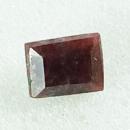|
ClassicGems.net |
|
|
 |
| Danalite |
|
|
Discovered in 1866; IMA status: Valid (pre-IMA; Grandfathered) | |||
|
|
|
Chemistry |
|
|
| |
|
Fe2+4Be3(SiO4)3S | |
|
|
Iron Beryllium Silicate Sulfide |
|
Molecular Weight: |
558.74 gm |
|
Composition: |
Beryllium |
4.84 % |
Be |
13.43 % |
BeO |
|
|
Iron |
39.98 % |
Fe |
51.43 % |
FeO |
|
|
Silicon |
15.08 % |
Si |
32.26 % |
SiO2 |
|
|
Sulfur |
5.74 % |
S |
5.74 % |
S2- |
|
|
— |
— % |
S |
-2.86 % |
-O=S |
|
|
Oxygen |
34.36 % |
O |
|
|
|
|
|
100.00 % |
|
100.00 % |
= TOTAL OXIDE |
|
|
|
||||
|
Classification |
|
|
| |
|
Silicates (Germanates) | |
|
8/J.12-10 | |
|
|
9 : SILICATES (Germanates)
|
|
Related to: |
Helvine Group. Danalite-Genthelvite Series. Danalite-Helvine Series. |
|
Members of Group: |
Helvine Group: Danalite, Genthelvite, Helvine, Tugtupite |
|
Varieties: |
None |
|
Synonyms: |
ICSD 201639, PDF 11-491 |
|
|
|
|
Crystal Data |
|
|
|
|
|
As octahedral and dodecahedral crystals, to 10 cm; as irregular segregations. |
|
|
None |
|
|
|
|
|
Physical Properties |
|
|
|
|
|
Poor/indistinct; poor on {111} |
|
|
Irregular/uneven, sub-conchoidal |
|
|
Brittle |
|
|
5.5 - 6.0 |
|
|
3.28 - 3.26 (g/cm3) |
|
|
None |
|
|
Not Radioactive |
|
|
|
|
|
Optical Properties |
|
|
|
|
|
Yellow, pink, reddish brown, red; colorless to pink in thin section. |
|
|
Translucent to semi-transparent |
|
|
Vitreous, Greasy |
|
|
1.747 - 1.771 Isotropic |
|
|
0.000 - Isotropic minerals have no birefringence |
|
|
n/a |
|
|
None |
|
|
|
|
|
Occurances |
|
|
|
|
|
Geological Setting: |
In granites, granite pegmatites, zones of contact metamorphism, skarns, and gneisses. |
|
Common Associations: |
Magnetite, Garnet, Fluorite (skarn); Albite, Cassiterite, Pyrite, Muscovite (tin-bearing pegmatites); Arsenopyrite, Quartz, Chlorite (hydrothermal deposits) |
|
Common Impurities: |
Mn, Zn, Ca, S |
|
Type Locality: |
Rockport, Essex Co., Massachusetts, USA |
|
Year Discovered: |
1866 |
|
View mineral photos: | |
|
|
|
|
More Information |
|
|
|
|
|
| |
|
|
|
|
Danalite is a rare beryllium silicate sulfide mineral that is a member of the Helvine Group of minerals that also includes Danalite, Genthelvite, Helvine and Tugtupite. Danalite was first described in 1866 from a deposite in Essex County, Massachusettes, USA. Danalite can be found in colors of yellow, pink, reddish brown or red but seldom crystalized and most often found as red to pink opaque masses in rock. Danalite is translucent to semi-transparent with vitreous to greasy luster and a Mohs hardness of 5.5 - 6.0. Faceted gems are very rare and typically very small. Danalite was named in 1866 by Harvard mineralogist and chemist Josiah Parsons Cooke Jr. (1827-1894) to honor American geologist, mineralogist, volcanologist, and zoologist James Dwight Dana (1813-1895). Dana is credited with naming more than 100 minerals. He also published more than 200 titles of books, manuscripts and papers beginning in 1835 with a paper on the conditions of Mount Vesuvius. Dana's best known books were his System of Mineralogy (1837), Manual of Mineralogy (1848) and Manual of Geology (1863). These books are very well known in the fields of mineralogy and geology. The Manual of Mineralogy became a standard college text and has been continuously revised and updated. The 23rd edition is now in print under the title Manual of Mineral Science (Manual of Mineralogy) (2007). Dana's System of Mineralogy has also been continuously revised and updated with the 8th edition being published in 1997 under the title Dana's New Mineralogy. Danalite can be found at the following localities: in the USA, at Rockport and Gloucester, Essex County, Massachusetts; on Moat Mountain, Conway, Carroll County, New Hampshire; at Iron Mountain, Sierra County, New Mexico; and from the Black Hills, south of Jerome, Yavapai County, Arizona. From Needlepoint Mountain, McDame area, British Columbia, and on Walrus Island, James Bay, Quebec, Canada. In Sweden, from Yxsjö, Örebro. At Redruth, St. Just, Lanlivery, Falmouth, and Lanivet, Cornwall, England. In Russia, from Imalka, Transbaikal, and other less-well-defined localities. From the Kara mine, Tasmania, and on Mt. Francisco, Ribawa area, Western Australia. In the Mihara mine, Hiroshima Prefecture, Japan. |
|
|
Danalite gems for sale: We have not photographed our Danalite gems yet. Please check back soon. |